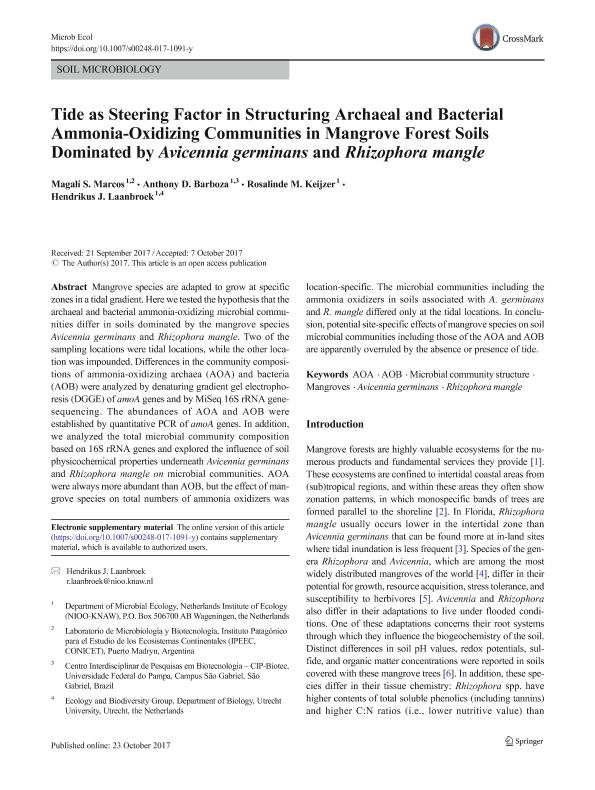Mostrar el registro sencillo del ítem
dc.contributor.author
Marcos, Magalí Silvina

dc.contributor.author
Barboza, Anthony D.
dc.contributor.author
Keijzer, Rosalinde M.
dc.contributor.author
Laanbroek, Hendrikus J.
dc.date.available
2018-10-09T19:18:37Z
dc.date.issued
2018-05
dc.identifier.citation
Marcos, Magalí Silvina; Barboza, Anthony D.; Keijzer, Rosalinde M.; Laanbroek, Hendrikus J.; Tide as Steering Factor in Structuring Archaeal and Bacterial Ammonia-Oxidizing Communities in Mangrove Forest Soils Dominated by Avicennia germinans and Rhizophora mangle; Springer; Microbial Ecology; 75; 4; 5-2018; 997-1008
dc.identifier.issn
0095-3628
dc.identifier.uri
http://hdl.handle.net/11336/62009
dc.description.abstract
Mangrove species are adapted to grow at specific zones in a tidal gradient. Here we tested the hypothesis that the archaeal and bacterial ammonia-oxidizing microbial communities differ in soils dominated by the mangrove species Avicennia germinans and Rhizophora mangle. Two of the sampling locations were tidal locations, while the other location was impounded. Differences in the community compositions of ammonia-oxidizing archaea (AOA) and bacteria (AOB) were analyzed by denaturing gradient gel electrophoresis (DGGE) of amoA genes and by MiSeq 16S rRNA gene-sequencing. The abundances of AOA and AOB were established by quantitative PCR of amoA genes. In addition, we analyzed the total microbial community composition based on 16S rRNA genes and explored the influence of soil physicochemical properties underneath Avicennia germinans and Rhizophora mangle on microbial communities. AOA were always more abundant than AOB, but the effect of mangrove species on total numbers of ammonia oxidizers was location-specific. The microbial communities including the ammonia oxidizers in soils associated with A. germinans and R. mangle differed only at the tidal locations. In conclusion, potential site-specific effects of mangrove species on soil microbial communities including those of the AOA and AOB are apparently overruled by the absence or presence of tide.
dc.format
application/pdf
dc.language.iso
eng
dc.publisher
Springer

dc.rights
info:eu-repo/semantics/openAccess
dc.rights.uri
https://creativecommons.org/licenses/by-nc-sa/2.5/ar/
dc.subject
Aoa
dc.subject
Aob
dc.subject
Avicennia Germinans
dc.subject
Mangroves
dc.subject
Microbial Community Structure
dc.subject
Rhizophora Mangle
dc.subject.classification
Otras Ciencias Biológicas

dc.subject.classification
Ciencias Biológicas

dc.subject.classification
CIENCIAS NATURALES Y EXACTAS

dc.title
Tide as Steering Factor in Structuring Archaeal and Bacterial Ammonia-Oxidizing Communities in Mangrove Forest Soils Dominated by Avicennia germinans and Rhizophora mangle
dc.type
info:eu-repo/semantics/article
dc.type
info:ar-repo/semantics/artículo
dc.type
info:eu-repo/semantics/publishedVersion
dc.date.updated
2018-05-23T13:35:07Z
dc.identifier.eissn
1432-184X
dc.journal.volume
75
dc.journal.number
4
dc.journal.pagination
997-1008
dc.journal.pais
Alemania

dc.journal.ciudad
Berlin
dc.description.fil
Fil: Marcos, Magalí Silvina. Consejo Nacional de Investigaciones Científicas y Técnicas. Centro Científico Tecnológico Conicet - Centro Nacional Patagónico. Instituto Patagónico para el Estudio de los Ecosistemas Continentales; Argentina. Netherlands Institute of Ecology; Países Bajos
dc.description.fil
Fil: Barboza, Anthony D.. Universidade Federal do Pampa; Brasil. Netherlands Institute of Ecology; Países Bajos
dc.description.fil
Fil: Keijzer, Rosalinde M.. Netherlands Institute of Ecology; Países Bajos
dc.description.fil
Fil: Laanbroek, Hendrikus J.. Utrecht University; Países Bajos. Netherlands Institute of Ecology; Países Bajos
dc.journal.title
Microbial Ecology

dc.relation.alternativeid
info:eu-repo/semantics/altIdentifier/doi/https://dx.doi.org/10.1007/s00248-017-1091-y
dc.relation.alternativeid
info:eu-repo/semantics/altIdentifier/url/https://link.springer.com/article/10.1007%2Fs00248-017-1091-y
Archivos asociados
